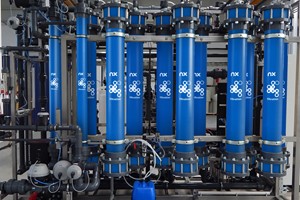Environmental, Social, and Governance (ESG) standards continue to be a difficult road for water and water treatment providers. ESG is a multi-faceted pursuit that spans dozens of metrics, across a wide range of highly public performance indicators. Furthering all three goals is a challenge for even the most progressive water utilities and water treatment providers.
The E in ESG often receives most of the focus, especially from the public. After years of focusing on the oil and gas segments, environmental advocates are beginning to expand their attention to include the water industry. Yet water organizations deal with a far different, and often more confined, list of issues than O&G.
Carbon emissions and greenhouse gases are global, cross-border problems. Water organizations, on the other hand, must deal with environmental challenges that are more geo-specific, involving local sources, like geography and weather, and end-users. The quality, pollution control, and equity issues that lead most water agendas are heavily influenced by these conditions. In recent years, availability — traditionally a problem plaguing foreign countries — has also been added to the list of domestic concerns, as water shortages in the American West afflict millions.
As for the other components of ESG, social and governance goals may not grab as many headlines in the water industry but are nonetheless important to many stakeholders. Activists and investors are insisting on progress in everything from racial justice to leadership accountability — regardless of if progress in those areas can actually be quantified.
Benchmarks Lacking
Meeting ESG demands are not easy, largely because regulation, standardization and measurement goals are either vague or non-existent. Environmental improvement, though expensive, is in many ways the easiest to measure. More challenging by far, are the other aspects of ESG. According to a 2021 BNP Paribas study, most investors feel social progress is especially difficult to evaluate due to a lack of standardization around social metrics.
Social action spans a long list of priorities that reflect societal concerns, from labor practices and data security to human rights and consumer protection. Definitions of improvement can differ from one stakeholder to the next — and without a standardized framework for furthering social good, there is no way to judge how well one enterprise is doing compared to others.
Investors, as well as interest groups and the general public, are demanding solutions. A Harvard report found that there is mounting pressure from investors for a mandatory reporting framework that allows meaningful evaluation and comparison of ESG practices and impacts.
Still, many water enterprises struggle with their ESG priorities. In addition to public groups, customers in a range of industries from semiconductors to cosmetics are demanding that providers accelerate ESG compliance in order to help them meet their own ESG targets. Furthermore, as companies in the water and wastewater industries continue to consolidate, compliance targets have become increasingly difficult to meet and plan for. Bluefield Research reported 498 water M&A deals in 2021, with values totaling $80 billion — a 34% increase over the number of deals from the previous year. Much of this deal activity was attributed to shareholder and governmental pressure for ESG and corporate sustainability, showing unprecedented interest and commitment to addressing ESG goals.
Data Analytics Are Critical
Meeting ESG expectations depends on the ability to make wise corporate decisions, often involving the best use of assets. Timely and accurate data, and the systems to evaluate that data, can help.
Today, water service providers have more options for data collection than at any time in history — and the sources keep growing. The IoT (Internet of Things) revolution has produced smart meters, sensors, mapping devices and many other technologies. SCADA (supervisory control and data acquisition systems), as well as security monitoring, maintenance management, laboratory information management, accounting/business systems, and more, can all be used for ESG management.
Analytics is the other half of the solution. Asset Investment Planning (AIP) software solutions are designed specifically for long-term capital planning. By leveraging the wealth of data available, these systems help manage finite human and physical resources, execute lifecycle planning, and improve cost-efficiency.
For critical investment decisions, asset investment planning solutions allow decision-makers to examine various scenarios and ask, “What will my reality look like? What should I be considering? How should I be preparing for it?” This modeling capability gives executives the power to measure trade-offs in time, cost, environmental impact, and other factors, in order to arrive at the best course of action.
Asset investment planning solutions help decision makers make better choices regarding capital expenditures while taking into consideration any ESG goals. Decision analytics can provide a decision framework for critical environmental objectives like carbon footprints.
When full datasets are not available or complete, advanced technologies can fill the gap. Powered by AI, these capabilities can close blind spots and allow organizations to build models with high degrees of confidence. AI-driven platforms make it possible for work to move forward, even when a complete picture isn’t possible or practical.
Multiple Benefits
By “asset-izing” water networks, asset management analysis can give organizations the clarity that is crucial to ESG administration. Digital twins allow providers to explore “what-if” scenarios. Some platforms support degradation modeling to forecast failures and upcoming risks that would otherwise be impossible to predict, enabling operators to set priorities for one, two, even five years in the future and beyond.
Asset Investment Planning software ingests data from different software applications to empower decision makers and allow them to choose the optimal strategy to achieve the organizations’ objectives.
AIP is also proficient at meeting the social and governance aspects of ESG. The ability of AIP to digitize an organization’s decision-making policies improves corporate governance, ensuring decisions are made in a consistent way. Also, this software can help companies determine when and how the necessary employee programs and benefits can be implemented to ensure a positive employee experience.
It's clear that ESG is here to stay — and with so much on the line, water and water treatment enterprises have no choice but to respond to its imperatives. Fortunately, data-based decision support, enabled by advanced analytics, can accommodate ESG demands and turn them into a planning component that benefits all concerned.
Analytics provide synergy, accelerate business momentum, and create actionable value. ESG is a transformative development for any public company, which means it requires a transformation in decision-making as well. There’s never been a more important time to get started.
Didem Cataloglu













